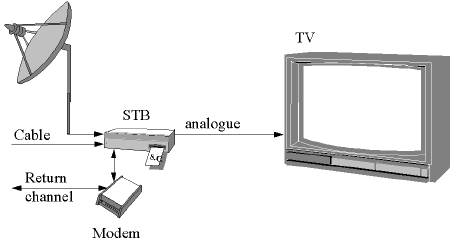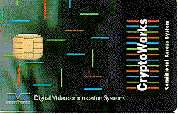
 |
JPL's Wireless Communication Reference Website
Chapter: Network Concepts and Standards
|
 |
| Basic configuration of a Pay TV system |
It is easiest to understand the system from the receiver side, where the system usually consists of a set-top box (also referred to as the decoder box), some detachable module such as a smart card, and the television set itself. The system will only work if the card is plugged into the box. The system works roughly as follows.
Before transmission, the normal, or clear signal is scrambled. This means that it is distorted in such a manner that normal viewing of the service becomes impossible. At the receiver side, de-scrambling is carried out to convert the scrambled signal back to the clear signal. The clear signal is then fed into the television set. The de-scrambler itself is a piece of hardware located inside the set-top box, but its control is carried out by the conditional access system, located on the smart card. The conditional access system only allows the de-scrambler to operate if the customer is authorized to watch the service.
Authorization is done by sending a safely encrypted authorization message (Entitlement
Management Message, EMM) to the customer which, after reception and
decryption, is stored on the card. The authorization messages are usually sent
well in advance of the service that they authorize. A second type of (encrypted)
messages describes each service, and these messages (Entitlement Control
Messages, ECM's) are sent together with the actual service data.
Upon receiving an ECM, the smart card checks if the customer is authorized to
receive the service, and only if this is the case, the de-scrambler is turned
on by issuing of the appropriate key. These keys are often conveyed in encrypted
form in the ECM's themselves. For a more detailed description of the control
messages click here.
 |
Photo: Smart cards for the heart of the security of many Conditional Access TV systems. This one can support access to up to four different broadcasters. Courtesy: Philips Digital Video Systems (DVS). |
On the transmission side, the system usually comprises several large subsystems that may be physically located in different buildings. A typical setup consists of the following equipment. First there is the equipment for playback and scheduling, usually located in the studio. There is also a computer based Subscriber Management System, (SMS), needed to do all the administration and billing. The SMS includes an order entry system that passes the orders on to the Subscriber Authorization System, (SAS). The SAS on its turn converts the orders into EMM's, which are then injected into the service. Other equipment necessary include a generator and an injector for the ECM's, and several control systems. All in all, the equipment on the transmission side is quite extensive and it is usually highly tuned to a specific conditional access system.
Over the past decade, several conditional access systems have been introduced. The following are only a few examples from Europe:
For a more complete overview of video broadcasting systems that are currently available on the market and hacks on them click here. For a short overview of the hardware in the boxes that is subject to the hackers interest click here.
Service providers are reluctant to accept storage devices. A subscriber to a pay-TV channel may copy a pay service on a VHS tape or other media and pass it on to its neighbour. To avoid that this neighbour can use the pay service without paying the service provider copy(right) protection methods are build in the de-scrambler boxes. For more information on copy(right) protection methods click here.
The incompatibility of the systems however poses a problem to the customer; if he wishes to receive another service, he has to rent or buy an additional decoder box and smart card. Especially if the other service is new on the market, it is really not likely that the customer is willing to do that. A solution to the problem could be to let this new service be accessed through the already installed boxes, which means that the two service providers would have to come to some mutual agreement. Recent examples of this can be found in the UK where BSkyB has reached such agreements with TV Asia, UK Gold and many more.
DVB aimed at developing a standardized, digital solution for conditional access. (more on DVB-CA).